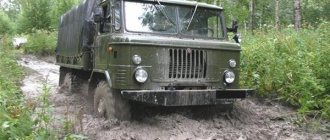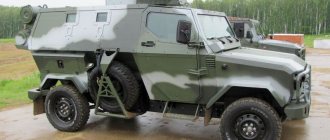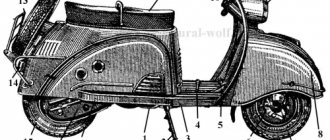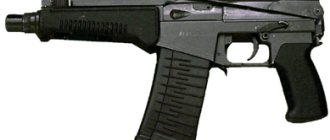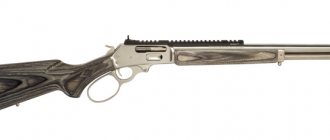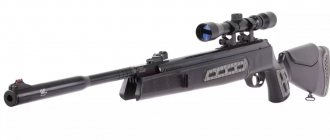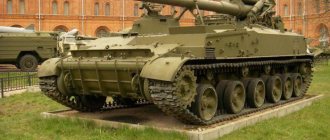ZIL 130 is a legendary truck of the Soviet era. In the line of the Likhachev plant, the model is the most widespread and successful product. The production of the car was organized at various enterprises, and the total production volume exceeded 3 million copies. The ZIL 130 has been on the assembly line of the Likhachev plant since 1964 and for a long time remained the standard in the medium-tonnage truck segment. For that period, this was a progressive model with high rates of profitability and durability.
The car was used in various fields, and the number of versions created on its basis reached several dozen. By the end of the 1980s, the ZIL 130 was seriously outdated. The design of the model, which had changed slightly since the start of production, no longer provided a competitive advantage. As a result, the car gave way to more progressive analogues. Currently, the ZIL 130 is difficult to find on the roads of the country. However, individual enterprises and farms continue to use this model.
Engine
The V-shaped eight-cylinder 4-stroke engine ZIL-130 has an economical volume of about 6 liters. At first, the truck’s engine was carburetor-powered, but after 10 years of use, a model version with natural gas was launched. If it is gasoline, the fuel consumption of the ZIL-130 per 100 km is approximately 30 liters. In this case, you can use inexpensive A-72 or A-76 fuel. The technical nuances of the engine are shown in the table.
| Power scheme | Carburetor |
| Number of valves | 2 |
| Number of cylinders | 8 |
| Position | Front, longitudinal |
| Power in hp |
135-150
Models have also been developed for cold climate zones with pre-heating.
Principle of operation
During operation, the water in the tank enters the inlet of the centrifugal pump. The liquid first passes through a water filter and a central valve. Subsequently, the pump directs the incoming water through the pipeline to the nozzles. The pressure water supply is equipped with two outlets to the valve, which are located in the side part. Fire hydrants are connected through these holes.
In this case, the pump pumps out liquid through a central valve and a strainer. Water is supplied to the pressure pipe and from there to the nozzles. The operation of the central valve is adjusted using a hydraulic cylinder. If necessary, the operator can change the angle of rotation of the nozzle used.
The operation of the watering machine in fire-fighting mode requires the operator to first connect the fire hose to the pipeline outlet. All other valves and taps must be tightly tightened. Otherwise, the necessary pressure will not be created.
The power take-off for driving the working parts is carried out through the use of a transfer case from a component of the base chassis installation. In this case, the required torque is transmitted to the gear pump of the vehicle’s hydraulic drive. Additionally, transmission is also made to the brush drive and the water pump, which provides water supply. The brush, which is used to remove debris, is located in the central part of the machine - between the front and rear axles of the wheels. In relation to them, the brush is installed with a slope of 28 degrees.
The design features of the vehicle allow you to fill an empty tank in various ways. It is quite possible to get by with a connected hose and fill the container from a nearby body of water. The main function of collecting liquid here is performed by a special water pump. It is also possible to fill the tank using a hydrant. An alternative way to resolve the problem is through the top hatch at a specialized gas station.
Transmission
The synchronous rear-wheel drive gearbox is equipped with helical gears of constant clutch. Torque is supplied to the rear axle, as a result of which the ZIL-130 “Kolkhoznik” has better grip on dirt and asphalt roads.
| Volume in l. | 5.99 |
| Rotation in rpm | 3200 |
| Temperature reduction method | Air-liquid |
| Tank volume, l. | 176 |
| Maximum speed km/h | 90 |
| Switch box | Mechanics |
| Number of positions | 5 |
| Drive unit | Rear wheel drive |
Device
ZIL 130 has a fairly simple design. The front suspension is built on 2 semi-elliptic springs with shock absorbers and rear sliding ends, the rear suspension is built on 2 main and 2 additional semi-elliptic springs. These elements also received sliding ends.
The car has a rear-wheel drive axle and a dry clutch with a single disc. The ZIL 130 transmission is mechanical with one disc and a pair of synchronizers (for 2nd and 3rd, 4th and 5th gears). The 5-speed gearbox has a constant gear engagement with the exception of reverse and 1st gears. For the automotive industry of that time, this unit was considered new, but during its operation it changed several times. Torque is transmitted from the gearbox to the rear axle via a cardan shaft. For the ZIL 130 model, two shafts mounted on the frame were used. For versions with a shortened base, one shaft was used without an intermediate support. The first transmissions for the car were designed in 1961; 6 years later they underwent minor changes. In the restyled gearbox, the retaining ring was removed. The gear shift knob was insulated with a special rubber seal, which prevented moisture from entering the gearbox. The crankcase was made of high quality cast iron.
Body Features
All types of body imply either rear unloading or unloading to the side. The dimensions of the body are as follows: the height is equal to the height of the railway car, which speeds up loading/unloading; platform area is 8.7 m2; The body volume of a standard ZIL-130 dump truck is 5 cubic meters. In Soviet times, the large size of the body, as well as the spacious ZIL cabin, made it possible to use the vehicle for transporting workers. See the table for body volume data.
| With installed sides | 7.8 m3 |
| Without sides | 5 m3 |
| Platform area | 8.7 m2 |
| Unloading directions | Straight and sideways |
| Climbing angle | 50 gr. |
| Platform size | 2325 by 3752 mm |
Hydraulics
The body lifting/lowering technology includes a 17 liter hydraulic fluid tank, a mechanical pump and a lifting hydraulic cylinder.
Load capacity and overall dimensions
The ZIL-130 dump truck initially had a load capacity of 4 tons; At present, the carrying capacity of the ZIL-130 vehicle has reached 6 tons. A maximum load of 2.625 tons is possible for the front axle, and 7.9 tons for the rear axle. In the table, we consider the general dimensions of this truck.
| Width (in millimeters) | 2500 |
| In height | 2400 |
| In length | 6675 |
| Wheel base | 3800 |
PURPOSE
Since its appearance, a huge number of different versions of the ZIL 130 have been created, which has significantly expanded the scope of the vehicle. The machine was actively used in almost all directions: in construction, the commercial segment, agriculture, and public utilities. The main purpose of the equipment was to transport cargo of various weights. The ZIL 130 was supplied to the army, where it established itself as a reliable truck suitable for transporting personnel and cargo. The model has been used by emergency services and rescuers.
ZIL 130 was actively exported. Models with foreign units from Layland, Perkins and Valmet could be found in 40 countries around the world, including countries with tropical climates and regions of the Far North.
The car moved confidently along field roads and light off-road conditions and was designed for garage-free storage. Despite its obsolescence, the ZIL 130 has not lost its relevance today. Thus, fire and rescue services in Russia and Ukraine continue to use these vehicles.
Additional characteristics and modifications
The brakes are of the shoe-drum type; operate using pneumatics. To operate the braking system, a compressor is used that fills the corresponding cylinder with compressed oxygen - the efficiency at 2 thousand revolutions is 220 l/m. The truck's electrical power comes from a battery. Voltage - 12 V; current - 90 A/h. Tire size (tires) - 260-508(P) R20.
For the automotive industry of the USSR, a fairly advanced steering system was used: a hydraulic booster with a double vane pump rotating from the crankshaft via a belt was then considered an innovative solution. To find out how much the ZIL-130 weighs, you need to determine the name of the specific model. The weight of the standard version is 4300 kg.
5 modifications of the car were developed:
- 130A - onboard tractor;
- 130B - dump truck, widely used in agricultural work;
- 130V - truck tractor;
- 130G - extended flatbed truck with a platform;
- 130W - with a reinforced rear axle, a distinctive feature.
Notes
- Eight-ton three-axle ZIL - Behind the wheel, 1976, No. 8
- ZIL diesel trucks - Behind the wheel, 1979, No. 11
- Brief automobile reference book NIIAT. Tenth edition, revised and expanded - M., Transport, 1985
- 700 thousand rubles for the Soviet truck “Baba Yaga” // Article dated May 21, 2019, “Mail.ru”.
- Glukhovsky D. M., Melamud R. A., Mitrofanov V.
P. Cars of the ZIL-133 family. - M.: Transport, 1984. - 328 p. - KAvZ in chronological order
Technical characteristics of the dump truck
The technical characteristics of the ZIL-130 car exceeded all expectations. A windshield washer appeared, the engine was heated before starting, and the cabin became a three-seater cabin. The car has become more comfortable.
Engine
The engine on the ZIL-130 is a v-shaped, eight-cylinder, 4-stroke “HORSE”. The working volume of the ZIL-130 engine is almost 6 liters, which, given its rather massive dimensions, is very economical.
Initially, the engine was a carburetor type, the overhead valve engine was intended for diesel fuel, but after 10 years of operation they began producing it for natural gas.
Table 1 - Technical characteristics of the ZIL-130 engine
| Name | ZIL-130 |
| Location | Longitudinal, front |
| Supply system | Carburetor |
| Cylinders, pcs. | 8 |
| Valves, pcs. | 2 |
| Volume, l | 5,99 |
| Power, hp | 150 |
| Rotation speed, rpm. | 3200 |
| Cooling | Liquid-air |
Improved synchronized rear-wheel drive gearbox (Gearbox) ZIL-130 with helical gears of constant mesh. Torque is transmitted to the rear axle, which provides more effective traction on asphalt roads or unpaved surfaces.
Table 2 — ZIL-130 gearbox design
| Gearbox | Mechanical |
| Number of speeds | 5 |
| Drive unit | Rear wheel drive |
Body
Depending on the modification, there were bodies with side and rear unloading. The height of the body was the same as the height of a railway car, which simplified loading and unloading of goods.
The volume of the ZIL-130 body is 5 cubic meters, and the platform area is 8.7 square meters. Due to the fact that the body volume of the ZIL-130 dump truck is quite large, it was sometimes used in agriculture, for transporting workers.
Brake system
Front, rear and parking brakes are standard, shoe, drum type. They are driven by pneumatics.
MTZ 82 technical characteristics: description, prices, video.
Compressor
All the air is in a special cylinder under pressure, which is produced by the ZIL-130 compressor. The compressor efficiency on the ZIL-130 is 220 l/min. at 2000 rpm.
Power supply
Electrical equipment ZIL-130 is single-wire. Power is supplied from a 12 volt battery at a current of 90 A/h.
Dimensions and load capacity
Table 3 describes the dimensions of the dump truck.
Table 3 - Dimensions of ZIL-130
| Length, mm | 6675 |
| Width, mm | 2500 |
| Height, mm | 2400 |
| Wheelbase, mm | 3800 |
The curb weight of the ZIL-130 is 9,360 tons, and the weight of the unloaded heavyweight ZIL-130 is 4.3 tons. The carrying capacity of the ZIL-130 dump truck varied depending on the model and dimensions of the cargo.
Initially, the maximum carrying capacity was 4 tons, but then reached 6 tons. The maximum load on the front axle is 2.625 tons, and on the rear axle - 7.9 tons, respectively.
STORY
In the mid-1950s, the growth rate of industry and agriculture in the USSR accelerated noticeably. The ZIS 150, developed in the pre-war period, could no longer meet the increased needs due to the obsolescence of the design. ZIL 164, which appeared in 1957, became a temporary solution and did not completely solve the problem, since it was a deep modernization of the ZIS 150. The country needed a fundamentally new car. Product development took place in a short time; prototypes of the ZIL 130 appeared already in 1956. As a power plant, the 4-ton vehicle received a ZIL-120 unit, inherited from the previous model. This measure was temporary; soon an 8-cylinder 150-horsepower unit became the main engine. Testing and refinement of the model took 6 years; pilot batches of the ZIL 130 were released only in 1962. However, even after this, the car did not make it into the series; additional testing took another 2 years. Full production of the new model opened in October 1964.
The appearance of the ZIL 130 was a landmark event for the Soviet automobile industry. Domestic drivers received a model that surpassed all existing cars in terms of comfort. A 5-speed transmission with synchronizers for all gears (except first) and power steering significantly simplified control. The car started from a stop in second gear, and first gear was used only for steep climbs and off-road.
The design of the ZIL 130 was also innovative. The exterior of the truck was designed by Eric Szabo. The young specialist created a completely new image with stylish cabin contours, panoramic glass and an embossed radiator grille. The car received a hood layout in the American style. There was nothing like this among cargo models at that time.
The color of the car has also changed. If earlier cars were painted khaki for quick mobilization during the war, now sky blue has become the main color. The front of the ZIL 130 was made white. There were other colors (dark green, yellow), but it was sky blue that became the main one.
The model quickly gained consumer interest. In addition to beauty, the car had rich functionality and reliability. Before the overhaul, the ZIL 130 traveled 300,000 km, and its carrying capacity was 5 tons.
The successful design played a cruel joke on the car. For a long time since its appearance, there have been no changes in the design of the car. At the Likhachev plant they were engaged in the creation of cabover trucks, and practically no attention was paid to the modernization of the ZIL 130. Only in 1966 did the manufacturer think about improving the design of the model, which by that time was already seriously outdated. It was then that the first update of the series appeared. However, there were no major changes in the design of the model.
In 1978, production of the modernized ZIL 130-76 began, which differed in appearance from the original version in a modified “front end” (the headlights and sidelights were swapped).
In 1986, the series was updated again. The car was named ZIL 431410, but in terms of construction and design it turned out to be an almost complete copy of its predecessor. The main disadvantage of the car was the gasoline unit with low efficiency and environmental friendliness. The manufacturer developed the diesel engine independently, and the first ZIL 130 models with it appeared only in 1987. At the same time, most modifications continued to install the old gasoline engine.
Production of the series at the Likhachev plant was finally completed in 1994. The car was produced at the Ural Automotive Plant until 2010.
Technical characteristics of the truck crane
The KS-2561D and KS-2561DA truck cranes were designed on the basis of the ZIL-130 dump truck chassis. The modified chassis is cable-type with a fixed linkage and folding outriggers.
This “BABID” is equipped with a double-row roller or ball bearing mechanism. The boom, due to its solidity, is lattice, because it does not have a retractable function.
Table 4 - Technical characteristics of truck cranes based on ZIL 130 KS-2561D and KS-2561DA.
| Base car | ZIL-130 |
| Base chassis power, kW | 110 |
| Switch installation | — |
| main | fixed boom |
| replaceable | with extended boom, with extended boom and jib |
| Main boom length, m | 8 |
| Reach, m | 3,3-7 |
| Load capacity, t | 1,6 |
| Load lifting/lowering speed | 0,2-5,3 |
| Rotation speed, rpm | 0,3-2,5 |
| Length, m | 10,6 |
| Height, m | 3,65 |
| Width, m | 2,5 |
| Weight, t | 8,8 |
The advantage of truck cranes based on ZIL-130 is that the maximum boom lifting height is 15 meters. So this “Collos of Rhodes” easily lifts the load to the level of the 3rd - 4th floor.
Liebherr crane, description of the model range.
Read about the mini tractor Garden Scout T 12 reviews in the article by clicking on the link.
Cabin interior
The steering mechanism of the ZIL-130 was a screw with a special spherical nut plus a piston-rack. The hydraulic booster was built-in. The three-seater cabin is located immediately behind the engine. The seat is adjustable in length, height and backrest tilt. The main options in the cabin included a heater, a windshield wiper with two blades, and a glass washer. For the 60s, the cabin ergonomics are at the highest level. The instrument panel and functional instruments are located very conveniently for the driver.
The designers provided two ventilation hatches in the cabin roof. The radiator grille has become a memorable element. The cabin was made of solid metal and had three seats. The engineering staff did a great job, because the car was comfortable and was very different from many Soviet trucks. Drivers received improved conditions for performing their work.
It was much more comfortable to sit inside, because the changes also affected the width - it was increased by 1.2 meters when compared with the ZIL-164 model. Instruments and controls were optimally located in the spacious cabin. In addition, soft seats appeared - for the driver and for passengers (double). The driver's seat could now be adjusted in horizontal and vertical directions.
It was also possible to change the angle of the chair back and pillows. It was on the ZIL-130 that the hydraulic power steering wheel debuted. Thanks to this, not only the ease of driving the truck increased, but also its safety - if the front wheel broke, it was easier to keep the truck on the road.
Engine cooling system
Engine cooling system, liquid closed type, with forced circulation of coolant.
For normal engine operation, the coolant temperature must be maintained within 75...95 degrees.
In a warmed-up engine, coolant is sucked from the radiator into the liquid pump and, under a certain pressure, through two pipes of the pump is supplied to the left and right cylinder blocks and, passing through the windows in the inter-cylinder partitions, cools the cylinder liners.
cooling system
ZIL-130 ENGINE LUBRICATION SYSTEM
The lubrication system (Fig. 3.5) includes: oil filler neck, oil pan, oil pump with oil receiver. filters, oil cooler, lines, channels, oil dipstick and crankcase ventilation system.
The engines under study use a combined lubrication system, in which the most loaded parts are lubricated under pressure, and the rest by splashing and gravity flow.
Oil from the oil sump is sucked in by the oil pump through the oil receiver and flows from the discharge section of the pump into the oil filter and then through the main oil line to the crankshaft and camshaft bearings. Then it is supplied through channels in the block and cylinder heads to the rocker arm axles, rocker arms and to the compressor (in ZIL-130 and -645 engines).
The crankshaft main and connecting rod bearings, camshaft journals, valve axles and rocker arms, ignition distributor and oil pump compressor drive shafts are lubricated under pressure.
The cylinder bore and piston pins are splash lubricated. Camshaft gears, valve stems, lifters and camshaft lobes are gravity lubricated.
To maintain oil pressure within specified limits, the lubrication system is equipped with safety and bypass valves.
Lubrication system
ENGINE POWER SYSTEM
The Engine power system includes instruments and devices designed to store reserves, supply and purify fuel, purify air, prepare a combustible mixture of the required composition and remove combustion products. The power system (Fig. 441) of a carburetor engine includes: carburetor, fuel tank, fuel filters, fuel pump, fuel lines, air cleaner, intake and exhaust pipes, muffler.
The 3M3-53-11 and ZIL-130 engines are equipped with two-chamber carburetors K-126B and K-88AM, respectively.
engine power system
TRANSMISSION
The clutch (Fig. 7.1, a) on the cars under study is frictional, single-disk, located in a casing 12 attached to the flywheel 3, which serves as the clutch drive disc. Inside the casing there are the following parts: driven disk 4, pressure disk 5, which is connected to the casing using protrusions on the disk (for the GAZ-5342 car) or spring plates (for the ZIL-431410 and ZIL-645 cars), ensuring axial movement of the disk relative to clutch release housing; clutch release levers 6, pivotally mounted on needle bearings. The driven steel disk 4 with friction linings attached to it is connected through a torsional vibration damper to a hub 7 mounted on the splines of the drive shaft of the gearbox. The torsional vibration damper ensures smooth engagement of the clutch and rapid damping of torsional vibrations due to the elasticity of the springs 10 and the friction between the damper discs 9 and driven disk.
clutch
BRAKE CONTROL
ZIL vehicles use a braking system with a pneumatic drive (Fig. 10.5), which includes wheel brake mechanisms and pneumatic drive circuits for the working, parking and spare brake systems. The brake system of the ZIL-4331 vehicle, in addition, includes a brake mechanism and a pneumatic drive circuit for the auxiliary brake system (engine brake).
The brake mechanisms (Fig. 10.6) of the service brake system are installed on all wheels. The brake mechanisms of the rear wheels are common to the service, parking and spare brake systems.
The brake mechanisms are installed on calipers, which are attached to the flanges of the front axle axles with bolts, and to the flanges of the rear axle housing with rivets. Brake pads 2 with friction linings are installed on the eccentric axles fixed in the caliper. The axles 8 of the pads have eccentric supporting surfaces, allowing them to be correctly centered with the brake drum 7. When braking, the pads are moved apart by an expanding fist 4, and when released, they are tightened by springs.
Shaft 15 of the expansion fist (Fig. 10.7) rotates in a bracket bolted to the caliper. At the splined end of the shaft there is an adjusting lever with a worm gear 16 and a worm 14 located inside it, secured by a lock 17. The adjusting lever is connected to a membrane 3, installed between the body and the brake chamber cover, using a fork 11 with a pin 12 and a rod, and ensures a reduction in gaps between the brake pads and the drum, increasing as a result of wear of the friction linings.
brake control
CABIN ZIL-130
The cabin of ZIL-433360 vehicles is all-metal, three-seater, with a whole panoramic non-opening glass wind window of the “Triplex” type.
The cabin doors have sliding glass and rotating window windows. Raising the door windows and securely fixing them in the raised position is carried out by single-lever window lifters.
The cabin doors, left and right, have locks that can be opened from the outside with a key, & from the inside with a handle. The lock stopper in the down position prevents the doors from opening from the outside.
To open the rotary window of the door, you need to turn the locking handle by first pressing its button. Electric cab windshield wiper. The driver's seat is equipped with a suspension mechanism with adjustable stiffness depending on the weight; before sitting on the seat, the driver must turn knob 2 to set pointer 3 against the number on the scale corresponding to the driver's weight. The suspension can be locked, while the seat is fixed in a single (height) position.
The adjustment provides several fixed positions of the backrest and seat cushion. Types of adjustments are shown in Fig. 6. The cabin heater is designed to supply warm air into the cabin and heat the windshield glass in case it freezes. The tail of the car is of an integral type, folds to the front.
cabin ZIL-2014
OVERVIEW OF BASIC AND SERIAL MODIFICATIONS
The very first AMO ZIL
AMO 1 first
ZIL-005
AMO-ZIL
rocket launcher
ZIS-150
ZIL-157
ZIL-130
ZIL-133
ZIL-133GYA
ZIL-131
ZIL-4331
ZIL-43276 T
ZIL-433180
ZIL-5310
ZIL-TAPIR
ZIL-4329 V1
Price of new and used ZIL 131
Production of the ZIL 130 model ended in 2010, so it is currently not possible to purchase a new truck. However, these cars are still offered on the used market. Moreover, you can buy them for a fairly modest price. Models on the move will cost 35,000-80,000 rubles. The technical parameters and condition of used ZIL 130 cars will not be the best, but given the ease of repair and good characteristics, the car may well be useful in various fields. Price tags for versions of recent years (2009-2010) in excellent condition reach up to 400,000 rubles.
Analogs
Analogs of the ZIL 130 model include its predecessor ZIL 164 and the GAZ 53 car, which is similar in characteristics.
SPARE PARTS AND ASSEMBLY PARTS
SPECIAL EQUIPMENT BASED ON URAL, MAZ, KAMAZ ____________________
Spare parts for Ural, Kraz, MAZ, Kamaz trucks. Engine parts YaMZ-236, YaMZ-238
Review and characteristics of the ZIL-130 car
The ZIL-130 vehicle with a wheelbase of 3800 mm is designed for transporting goods on any roads as part of a road train (the total weight of the trailer should not exceed 8000 kg). The weight of cargo transported by a vehicle on all roads is 6000 kg.
Based on the ZIL-130 vehicle, the plant produces the following main modifications:
— ZIL-130G vehicle for transporting various long and low-density cargo and for towing trailers with a total weight of 8000 kg; the weight of cargo transported by a vehicle on all roads is 6000 kg (wheelbase 4500 mm);
— truck tractor ZIL-130V1 for towing various semi-trailers with cargo with a total weight, including the weight of the semi-trailer, 14,400 kg on paved roads (wheelbase 3300 mm);
— ZIL-130D1 chassis for equipping ZIL-MMZ-4502 dump trucks (manufactured by Mytishchi Machine-Building Plant) and ZIL-MMZ-555;
— ZIL-130D2 chassis with pneumatic outlet and towing device, designed for equipping the ZIL-MMZ-45022 dump truck;
— ZIL-130B2 chassis with pneumatic connection to the trailer and towing coupling device, intended for equipping the ZIL-MMZ-554M agricultural dump truck-tractor.
In addition to those listed, the plant produces several modifications of cars designed to operate in different climatic zones. Each such model of the ZIL-130 car has its own letter or digital index.
The service life of the vehicle, as well as the reliability and efficiency of its operation, largely depend on the running-in of parts during the initial period of operation.
After 1000 km of mileage of the ZIL-130 vehicle, you must:
— drain the oil from the engine, add fresh oil, and at the same time clean and rinse the centrifuge;
— carefully inspect the car and check the fastenings;
— tighten the nut securing the steering bipod;
— flush the cooling system;
— tighten the nuts securing the cardan transmission flanges;
— tighten the bolts securing the cylinder heads, intake and exhaust gas pipelines. After tightening the cylinder head bolts, it is necessary to check and, if necessary, adjust the clearances in the valve mechanism;
— check the tightness of the bolts securing the ears of the front and rear springs;
— check the tightness of the stepladders securing the front and rear springs to the rear and front axles, as well as the wheel nuts;
— check the free play of the clutch pedal;
— check and, if necessary, adjust the tension of the fan, compressor, generator and power steering pump drive belts;
— check the free play of the brake pedal, check the operation of the brakes;
— on a new car, when performing the first maintenance-1, remove the fabric liner from the mesh filter of the power steering pump, preventing dirt from getting into the pump reservoir;
- measure the carbon monoxide content in the exhaust gases using a gas analyzer and, if necessary, adjust the carburetor.
Technical characteristics of ZIL-130 trucks
Weight of transported cargo, kg:
— car — 6000 — chassis — 7075
Weight of a trailer or semi-trailer with cargo, kg (no more) - 8000
Weight of the equipped vehicle, kg - 4300
Gross vehicle weight, kg:
— without trailer or semi-trailer — 10525 — with trailer or semi-trailer — 18525
Distribution of curb weight of the vehicle, kg:
— to the front axle — 2120 — to the rear axle — 2180
Total weight distribution, kg:
— to the front axle — 2626 — to the rear axle — 7900
Overall dimensions of ZIL-130 in mm
Appearance
The foreshadowing versions of ZIL trucks were extremely unfinished and crude. The justification is compelling; a large amount of equipment was required to repair damage after the war. But in the end, already in 1956, prototypes were significantly more beautiful than their predecessors.
After a number of regular changes, which concerned both the restyling of the truck and the plant itself, the ZIL-130 was presented at the annual international fair in Leipzig, where it received a gold medal, and the engineers received many diplomas. Since that time, the “130” model began to gain unprecedented popularity.
The fact is that ZIL dump trucks had quite a lot of modifications. The most commonly used of these were semi-trailers and articulated dump trucks. The most significant modifications were made in 1966 and 1977. On the basis of the usual “one hundred and thirty”, fire engines and truck cranes, tank trucks and vans, flatbed vehicles and construction dump trucks were created.
The car is efficient even in cramped urban environments thanks to its turning radius of up to 7 meters. Having a carrying capacity of only 3 tons, the ZIL-130 itself weighs at least 4 tons. At the same time, it can be used to tow a trailer weighing no more than 8 tons. From the outside, the Russian truck looked very good for that time
The car was capable of attracting attention
It was painted white and blue. Before the ZIL-130, all automobile enterprises worked only for the defense and army spectrum, based on this, the car had a protective paint. The hood was alligator style. ZIL received streamlined wings and a panoramic windshield. In addition, the cabin was equipped with a ventilation hatch and windows.
Body
The body was supplied with a folding tailgate and was considered a cargo-passenger one. The gratings located on the sides were equipped with benches that could be folded back. They could fit 16 people. There was also a bench that could be removed - it could seat 8 people.
The basic modification of the ZIL-130 includes an awning along with arches, which can be removed and installed at any time. The body design is also practical. The height of the floor of the cargo compartment of the ZIL-130 is similar to the height of the floor in railway cars. This fact greatly simplifies the loading and unloading process.


